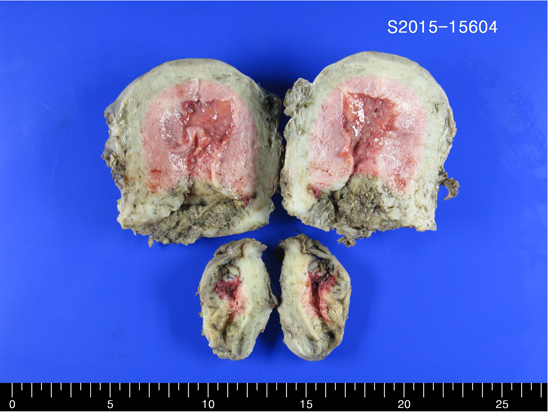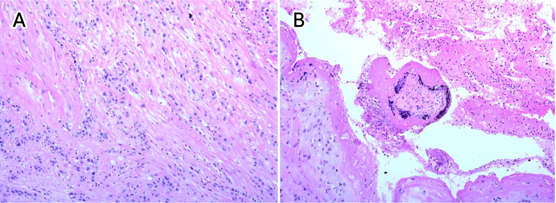Kosin Med J.
2017 Dec;32(2):263-268. 10.7180/kmj.2017.32.2.263.
Spontaneous uterine rupture due to placenta percreta in the second trimester of pregnancy: a case report
- Affiliations
-
- 1Department of Obstetrics and Gynecology, Inje University Haeundae Paik Hospital, Busan, Korea. wooki1974@empal.com
- 2Department of Pathology, Inje University Haeundae Paik Hospital, Busan, Korea.
- KMID: 2400272
- DOI: http://doi.org/10.7180/kmj.2017.32.2.263
Abstract
- A 32-year-old multiparous woman (gravida 2, para 2) with a history of previous cesarean section had acute abdominal pain and collapsed at 21 weeks of gestation. Exploratory laparotomy was performed because of the patient's worsening condition; ultrasound examination results were suggestive of massive hemoperitoneum, and fetus in vertex presentation with bradycardia. Uterine rupture between the left lower segment and borderline of the cervix in the anterior wall with active bleeding was confirmed. An uncomplicated classical cesarean section was performed, but the fetus was stillborn due to preterm birth. Hysterectomy was performed after the cesarean section. The patient was admitted to intensive care units for 3 days and was discharged in 12 days following delivery. Placenta percreta at the anterior lower segment of the uterus was confirmed in the pathology report.
MeSH Terms
Figure
Reference
-
1. Veena P, Habeebullah S, Chaturvedula L. A review of 93 cases of ruptured uterus over a period of 2 years in a tertiary care hospital in South India. J Obstet Gynaecol. 2012; 32:260–263.
Article2. Sutton C, Standen P, Acton J, Griffin C. Spontaneous Uterine Rupture in a Preterm Pregnancy following Myomectomy. Case Rep Obstet Gynecol. 2016; 2016:6195621.
Article3. Hofmeyr GJ, Say L, Gülmezoglu AM. WHO systematic review of maternal mortality and morbidity: the prevalence of uterine rupture. BJOG. 2005; 112:1221–1228.4. Kent A. Management of placenta accreta. Rev Obstet Gynecol. 2009; 2:127–128.5. Ultrasonography in Obstetrics and Gynecology. 5th ed. Philadelphia (PA): Saunders Elsevier;2008.6. Ulkumen BA, Pala HG, Baytur Y. Acute abdomen and massive hemorrhage due to placenta percreta leading to spontaneous uterine rupture in the second trimester. Saudi Med J. 2014; 35:1131–1132.7. Neyazi SM. Placenta percreta and uterine rupture at 16 weeks. Saudi Med J. 2013; 34:753–756.8. Park SH, Kim HS, Kim MH, Choi JS, Han JY, Hong SR, et al. Spontaneous uterine rupture with placenta percreta. Korean J Obstet Gynecol. 2003; 46:1236–1241.9. Kwon MJ, Chae KA, Shin HM, Kwon I, Lee GS, Kim SJ, et al. A case of Spontaneous uterine rupture due to placenta percreta on 1st trimester. Korean J Obstet Gynecol. 2003; 46:2538–2542.10. Ripley DL. Uterine emergencies. Atony, inversion, and rupture. Obstet Gynecol Clin North Am. 1999; 26:419–434.11. Roeters AE, Oudijk MA, Heydanus R, Bruinse HW. Pregnancy outcome after intra-abdominal bleeding due to placenta percreta at 14 weeks of gestation. Obstet Gynecol. 2007; 109:574–576.
Article12. Zwart JJ, Richters JM, Ory F, Vries JI, Bloemenkamp KW, van Roosmalen J. Uterine rupture in the Netherlands: a nationwide population-based cohort study. BJOG. 2009; 116:1069–1080.
Article13. Chauhan SP, Martin JN Jr, Henrichs CE, Morrison JC, Magann EF. Maternal and perinatal complications with uterine rupture in 142,075 patients who attempted vaginal birth after cesarean delivery: A review of the literature. Am J Obstet Gynecol. 2003; 189:408–417.
Article14. Sinha P, Mishra M. Caesarean scar pregnancy: a precursor of placenta percreta/accrete. J Obstet Gynaecol. 2012; 32:621–623.
- Full Text Links
- Actions
-
Cited
- CITED
-
- Close
- Share
- Similar articles
-
- A Case of Spontaneous Uterine Rupture due to Placenta Percreta on 1st Trimester
- A Case of Spontaneous Uterine Rupture in 17 Weeks of Pregnancy
- A Case of Spontaneous Uterine Rupture in the Second Trimester of Pregnancy
- Placenta Increta Presenting as Postabortal Uterine Mass in the First Trimester: A Case Report
- Spontaneous uterine rupture from placenta percreta at 33 weeks' gestation after a single gynecologic surgery



